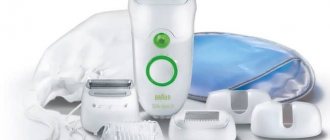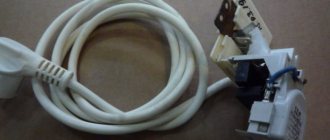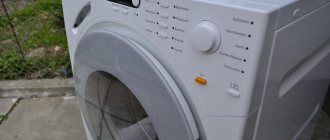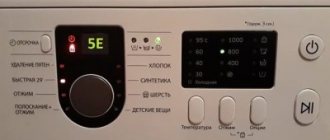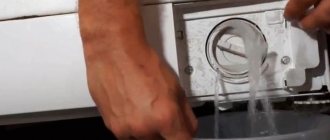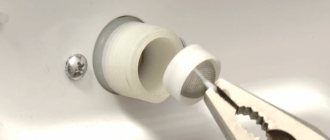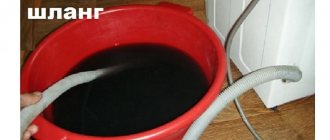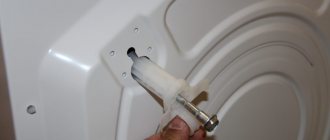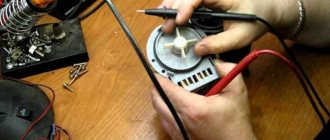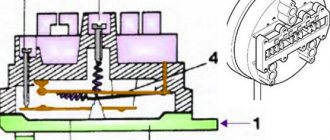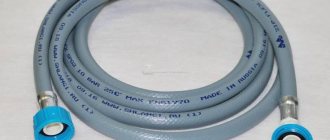Washing machine manufacturers produce sophisticated electronic devices with many functions that make life much easier for their owners. They can do everything - perform high-quality washing, steam and dry clothes. However, “smart” units remain defenseless against hard and rusty pipeline water.
How to prevent damage to your home assistant? This question is asked by many owners and potential buyers of washing machines. One of the effective methods is to install a filter for the washing machine, which protects the working units of the equipment from premature damage.
Let's figure out what types of filter elements exist, what are the features of their selection, installation, application and maintenance. The information presented will help organize comprehensive protection for the washing machine and extend the life of expensive equipment.
The effect of untreated water on washing machine parts
Rumor has it that the washing machine can function smoothly without any filters for many years. However, in modern realities this is far from the case. The reason for this is various impurities that pollute the water. What could they be?
Mechanical impurities (dirt, sand, small debris), if not removed, can over time significantly clog the internal cleaner. The pressure required to start water will gradually drop, which may cause the pump to break down and the device will stop drawing water.
Rust has a detrimental effect on the result of washing, because things fade, acquire new stains or are not washed at all.
If you do not promptly clean the water filter in your washing machine, the purifier will become clogged. And this may lead to machine breakdown
Hard water is no less dangerous. When heated, mineral deposits from the water settle on the heating element and the walls of the apparatus in the form of impenetrable scale. And this can provoke an increase in energy consumption to heat the water to the required temperature.
It is necessary to remove scale in a timely manner, otherwise a more serious breakdown may occur, requiring expensive repairs. To maintain the washing machine, you must periodically use an anti-scale agent.
In addition, hard water provokes corrosion - it is the key reason for the rapid wear of important parts and a decrease in the service life of the machine.
Also, untreated water often becomes a decisive factor in machine depressurization due to a decrease in the elasticity of rubber seals.
Situations indicating that it is necessary to clean a clogged filter:
- after washing or rinsing, the process of draining the water is incredibly slow;
- the machine completes the washing cycle and does not continue it even after rebooting the processor;
- a fault code flashes on the monitor, the direct cause of which may be untreated water;
- The spin or rinse modes do not start.
If such failures in the operation of the washing machine occur frequently, then it is worth thinking about the quality of water filtration.
TOP 5 best filters for washing machines
Despite manufacturers' statements that the washing machines they produce last a long time, some models may not survive until the established date.
The reason is the low quality of water that enters the house. It contains many impurities, which, during heating of the liquid, settle on the structural elements of the washing machine, which leads to premature failure. An additional filter for equipment will solve this problem.
How to clean the drain and fill filter
Initially, in all washing machines, for their productive and safe operation, the manufacturer already provides two factory filters:
- filler (or inlet) - installed immediately after the inlet pipe;
- drain (or outlet), which removes water after washing/rinsing.
Let's look at the design and maintenance features of each filter.
Overview of the inlet cleaner and its service
The inlet filter is mounted at the junction of the inlet hose with the machine. And at the very bottom of the device there is a drain filter; in various models it is located either on the left or on the right and is covered with a special rectangular cover.
Its main function is to retain large and medium-sized debris, which can cause malfunction or breakdown of the machine.
The instructions for the washing machine say that you need to call a specialist to clean the filters. But if the user is familiar with the tools, he will be able to perform these simple steps independently.
The inlet filter is cleaned in all brands and models according to the same principle - you need to carefully remove the thimble-like device using pliers
First, you need to disconnect the device from the network, turn off the water and free access to the back of the device. Be sure to place a piece of thick rag under the bottom of the washer to prevent water from flowing in there, and carefully unscrew the water-filling hose.
Then carefully remove the cleaner (it looks like a thimble) using tweezers or pliers. It is necessary to rinse the metal filter mesh under running warm water, using a toothbrush to remove dirt.
Then wipe with a rag (do not use a cloth with very long pile). After this, install the part in place and screw the hose.
The procedure for cleaning the drain type of filter
Different brands of laundry appliances differ slightly in design, and drain cleaners also differ.
Indesit washing machines , for example, the drain filter is cleaned in this way:
- You should carefully open the panel located on the left or right bottom of the device;
- remove the inner part by unscrewing the plug counterclockwise;
- After removing dirt and debris, you need to screw the element tightly in a clockwise direction until it stops.
When cleaning the filter of a Samsung , be sure to pay attention to the location of the screw handle.
In some models, for a tight seal, it must be locked in the correct position. If this is not done, water will flow out of the drain cleaner during the wash set.
The inlet mesh filter for purifying water in a washing machine is a small part that, if washed frequently, must be cleaned at least once every 3 months.
You can avoid contamination of the drain filter if you follow simple rules for its operation. It is necessary to wash the part regularly to prevent dirt from accumulating.
If you wash it a couple of times a day or once every 2 days, then it is enough to do only 1 cleaning every 3 months. In addition, you should carefully check pockets and other recesses in dirty laundry to prevent dirt, hair, and small parts from getting into the drum.
Try to use only proven detergents. It is better to test new ones by hand washing, since large particles of powder can only partially dissolve in water and clog the cleaner, especially if the program involves the use of cold water.
Washing machine filters
There are several filter options available for sale.
Each device has its own installation location:
- The main filter - for purifying water supplied through the water supply system - is installed on the pipe at the entrance to the apartment.
- The salt purifier is installed immediately before the water supply to the device. It softens the liquid and cleanses it of fine dirt, protects against the formation of scale and rust.
- The coarse cleaning device is attached to the thread. It needs cleansing and rinsing.
- Installation of the magnetic cleaner does not require additional cuts; you just need to secure it with bolts on top of the line.
Types of cleaning devices
To protect the parts of the electrical device from mechanical particles and chemical contaminants, users install special water purifiers for the washing machine.
Main filters . Such devices are installed on a common water supply pipe. The functionality of the main device is similar to a filler cleaner.
It is mounted on the inlet pipe to purify the incoming water from rust, sand and large particles. Please note that this type of filter does not affect the chemical and biological composition of water.
To install the main filter, it is necessary to make a separate insert in the pipe. The general cleaner is installed immediately after the meter and in front of the inlet hose.
The main filter is necessary for deep purification of water from mechanical impurities (dirt, debris, sand); it looks like a flask with an active filler inside
The coarse filter performs functions similar to the main filter, and at the same time it must be installed in front of the washing machine.
Please note that filters become clogged quite quickly. Therefore, it is necessary to regularly clean them and change replacement cartridges so that the washing machine lasts as long as possible.
Replacing the main cleaner cartridge is very simple - just turn off the water, carefully unscrew the flask and replace the old one with a new cartridge
The user can install a coarse filter for the machine without the help of specialists. You don't need to use any complicated tools to do this. Just take a wrench and screw the filter to the machine. The flask is mounted in front of the inlet hose.
To install, do the following:
- Turn off the water.
- Unscrew the inlet hose from the pipe to which it is attached.
- Install a water filter-purifier in its place.
- Then screw on the hose itself.
The cleaner uses standard threads that fit three-quarter inch pipes. The washing machine hose has exactly the same thread.
The quality of water purification will directly depend on the type of filter and how contaminated the tap water flowing through the pipes is.
To purify water at the biological level, softener filters are used:
- polyphosphate;
- magnetic.
Devices of this kind remove the notorious hardness from water, especially calcium carbonate salts. Their action is based on chemical or magnetic cleaning methods. Please note that after such filtering, process water will flow through the pipes and cannot be used for drinking.
Scope of application
Magnetic filters are not suitable for purifying water from hardness for drinking - salts remain in the liquid, only changing the form of crystallization.
The operation of these devices is effective in preventing scale formation in electric kettles, washing machines, dishwashers and heating systems. Installing such a water softener has several purposes:
- reducing existing scale and preventing the appearance of new ones;
- Increasing the service life of devices and reducing repair costs;
- stability of heat transfer from heating systems - it will not decrease due to the appearance of scale on the walls of the radiator;
- The quality of cleaning clothes and dishes with water becomes much better, and less detergent is required.
Magnetic softeners are used to treat large volumes of water; they are usually placed at the entrance of pipes into the apartment. Another application option is directional or point, i.e. The filter is placed in front of the device consuming water.
Features of additional filters
We will outline the features of various devices for water purification, describe their operating principles, installation specifics, and also find out the effectiveness of their use.
#1 - polyphosphate cleaning tool
A polyphosphate filter is a flask with large transparent grains similar to salt. It directly affects the biochemical composition of water. After purification with this filter, water becomes technical.
The principle of operation is based on the slow passage of liquid through sodium polyphosphate. When its active element reacts with water, it binds carbonates (a base of hardness salts) and blocks their path to the heating element and other parts of the washing machine.
Such filters are connected to a pipe with cold water, since at temperatures above +50 ° C the salt itself begins to break down, and in this case there will be no effect from this filter.
From time to time you will need to add polyphosphate to the filter flask, as its components dissolve.
Manufacturers recommend changing the filter filler if the contents of the flask have decreased by 50% or the contents of the container have not changed for a long time. As practice shows, crystals retain their cleansing functions for six months.
The polyphosphate filter protects the heating element of the washing machine from scale. Remember that after such cleaning, water can only be used for technical needs
The polyphosphate filler itself can be produced in different forms. Most often it can be seen in the form of translucent granules. Less popular is the powder version, which is produced in the form of pressed white tablets.
Experts recommend using the first option for washing machines, as it dissolves more efficiently and quickly, covering a larger area. Sometimes sodium polyphosphate is hidden under the name "Graham's salts."
Subtleties of installing a filter flask
A polyphosphate cleaner is installed in the same way as a deep cleaning filter. It should be mounted in front of the machine. Installation and replacement of the active filter substance can be handled without the help of a specialist.
#2 - filter for water deferrization
The presence of iron does not affect the operation of the washing machine in any way, since the process of deferrization of water occurs at the city’s water pumping stations. But what if you live outside the city or in the country?
First, conduct an experiment. Fill a glass jar with clean water. Place in a bright place for about 3 days. If, after this period, the walls are covered with a yellow coating (like rust) and the water has acquired a shade of the same color, then iron removal should be carried out.
There is no point in installing such a device for deferrization of water at the dacha, but residents of country houses need it
In this situation, a special filter is needed - a rather bulky device filled with “green sand”. In simple words, the principle of its action is the “transition” of divalent iron into trivalent iron.
Purifier installation specifics
Installation of the deferrization filter should only be carried out by specialists. Before installation, a water analysis is required. To install this device, you need to allocate a special place.
#3 - magnetic type of cleaner
The operating principle of a magnetic filter is based on the influence of a magnetic field on the structure of water in the pipe through which it flows.
In simple terms, the cleaner dissolves the calcite. It is this that makes the water harder and, accordingly, provokes the formation of scale when the heating element is heated.
The magnetic cleaner is attached directly to the water supply pipe to the machine; it does not require cartridge replacement
Calcite particles in their natural state stick to each other, thereby creating chains, so a deposit of the substance is formed on the machine part.
The magnetic field breaks these bonds and therefore the water purified by such a filter is actually softer. And the scale, which has already stuck to the walls of the machine, disintegrates and its particles, falling into the water, lose the ability to re-deposit on the surface.
That is why treated water tends to free the walls of the washing machine from other various sediments. Washing in such water requires less detergent, and the filter itself does not need to be cleaned.
Nuances of installing magnetic filters
Some models of magnetic purifiers consist of 2 elements that are attached directly to the top of the pipe through which water is supplied to the machine. Both parts of the magnetic filter are fastened together using screws.
Device and principle of operation
Before looking at how a magnetic water filter works, it is useful to know when you really need one. Water from any source can be divided into hard and soft depending on the amount of magnesium and calcium salts dissolved in it. The more of them, the harder the water is - it has a characteristic slightly metallic taste, like spring water.
In everyday life, this property can be detected by several signs: water causes dry skin, soap suds are weakly formed in it, and scale quickly forms on the kettle. If these effects of salts in water occur, it will be useful to install a magnetic filter.
Important! Hard water can cause significant damage to your washing machine, causing scale and corrosion.
Magnetic filters soften water by affecting the dissolved calcium and magnesium salts in the liquid. There are several modifications to the structure of the devices, but the general one is simple - a magnet located inside a steel case.
When water passes through the field of a magnet, the salts in it crystallize and change shape: from rectangles with a flat surface they become thin needles. In a new state, they cannot settle and create scale, but are in a suspended state. Those. water passing through such a device can reduce the amount of scale that has already settled.
Sometimes such devices are credited with an electromagnetic principle of operation: this is not entirely true, because water hardness decreases under the influence of only a magnetic field. Electromagnetic filters exist and are noticeably more expensive - this is a different class of devices for water purification.
What to look for when choosing?
If the water in the tap contains visible impurities that precipitate, it is advisable to install a general main purifier.
When this is not possible, the filter should be installed directly in front of the washing machine.
If you are sure of the hardness of your tap water, then it makes sense to install polyphosphate (economical option) or magnetic purifiers (more expensive purchase)
If you doubt whether a water softening filter is needed, order a laboratory test. It will show the chemical composition and level of hardness. Based on this information, decide which cleaner to purchase.
To find out the hardness of water at home, you need to carry out a basic experiment. To do this, soap your hands or a small rag with laundry soap (72%) and rub them.
If fluffy foam forms, then the water is soft and a filter is not needed, otherwise you should think about installing a softener.
About washing machine filters
If low-quality water containing foreign impurities enters a house or apartment, it is recommended to equip washing equipment with filters. There are several types available, and even more manufacturers, so this article will provide recommendations for choosing.
The differences between filters are the installation location and the functions they perform. Effective designs that have proven themselves in poor water conditions:
- mainline This device does not apply specifically to washing machines. Its action is of a general direction. The main filter purifies all water that enters the home. Such a powerful device is installed on the inlet water pipes. The function of this water purifier is to prevent foreign matter from entering the water. But it cannot affect the chemical composition in any way, so hard water will not become softer;
- deep cleaning. This device is designed specifically for washing equipment and is installed in front of the inlet hose. Its task is to retain rust, iron, sand and other substances that can penetrate into the water used for washing clothes. In this case, the filter does not affect the hardness of the liquid;
- polyphosphate. These water purifiers are the most popular. Sometimes there is another name for them - saline, since the flask contains a substance that looks like salt. The function of this device is to soften water. That substance, sodium polyphosphate, is consumable, so it will have to be changed from time to time. By loading the flask to the brim, this is enough for 10,000 liters of liquid. At the same time, the device is inexpensive and additionally protects the heating element of the washing machine from scale;
- magnetic. This device is also designed to soften water. This type of filter is not installed, but simply secured in front of the inlet hose. Magnetic purifiers have a beneficial effect on the chemical composition of water, making it softer. As a result, scale does not form on equipment parts.
What is it needed for
Many washing machines already have an integrated coarse cleaning system. As a rule, it is located next to the drain hose.
It successfully copes with retaining large debris, but it is unable to remove small inclusions; for this, water purifiers are already purchased.
Using a water filter is a reasonable expense. Although the device costs, sometimes impressively, it brings significant benefits - it extends the life of household appliances.
What does water filtration do:
- No foreign impurities get into the drum and other components of the washing machine. Without a filter, the “internal” cleaning system will quickly become clogged with dirt, which will lead to a decrease in pressure and water absorption capacity;
- Sand, rust and other elements are removed from the liquid. If you leave everything as is, the drain hose will clog prematurely, or even fail altogether;
- corrects water hardness.
The situation with bad water occurs in old houses where the water pipes have not been repaired for a long time. The liquid, passing through such pipes, “sucks in” harmful elements, which, accumulating in the components of the washing machine, lead to premature failure.
Criterias of choice
First of all, the water is submitted for analysis, and a filter device is selected based on the elements it contains.
In short, if there are a lot of third-party inclusions in the liquid (rust, sand, etc.) that precipitate, it is worth installing a main cleaning device that affects the entire home. If this fails, then an alternative is a filter installed in front of the washing machine.
Therefore, it is better to have two filters for the washing machine:
- one traps impurities;
- the second is used to soften water.
Still, in order to get rid of unnecessary manipulations, it is worth taking the water for analysis once and drawing a conclusion based on the results.
Manufacturers rating
Among the filtering devices that are on the market today, it is possible to note several of the most popular models.
Review of Geyser 1P
Main filter device manufactured by . Designed to purify water that enters the house, it is mounted on a water pipe with cold water, near the entrance. Provides cleaning from rust, plaque, grains of sand, and other debris. Thus, clean water will flow not only into the washing machine, but also into the dishwasher and boiler.
The working element is a polypropylene cartridge that cannot be cleaned. It needs to be changed from time to time. The cartridge body is resistant to pressure not exceeding 30 atmospheres. This is a compelling argument in favor of choosing this device for purchase.
Aquaphor and its Styron
Polyphosphate filter device manufactured by . Water purified with its help cannot be drunk. The device prevents rust from forming, removes existing scale, and softens the water. One portion of filler is enough for 300 washes.
Washing machine filters produced by the French company Group Atlantic are polyphosphate devices. These devices are distinguished by their average cost and effective water purification.
Aquashield Pro
This is a magnetic filtering device produced by NPI "Generation". The operation of the device is based on the action of a magnetic field on water. Water treatment is carried out without any chemicals. The filter housing is made of plastic. The device is equipped with a microcircuit and processor, as well as control keys. Through them it is possible to change the wave frequency in the range of 50 kilohertz.
2 emitter wires are connected to the body. They need to be wrapped around the pipe (direct the wires in different directions). The filter itself is also installed on the pipe. It operates at a voltage of 220 volts and consumes 5 kilowatts of electricity per month (maximum).
Water treatment is carried out by high-frequency electrical pulses. An electric field is formed across the pipeline channel. It charges foreign particles contained in the water. As a result, large particles are formed, which are subsequently destroyed by fine cleaning technology. The device is capable of purifying water from certain microbes.
Do you need a filter for your washing machine?
It is necessary to install a filter for cleaning on the machine. The coarse cleaning device removes impurities that, when entering the machine, will lead to its breakdown. Liquid containing sand and rust particles clogs the pump of the machine. The quality of washing decreases, the laundry becomes gray after washing. Under the influence of hard water, metal parts corrode, which significantly reduces operating time.
Experts say: for long-term operation of the washing machine, you need to install two filters to remove impurities and soften the hardness.
